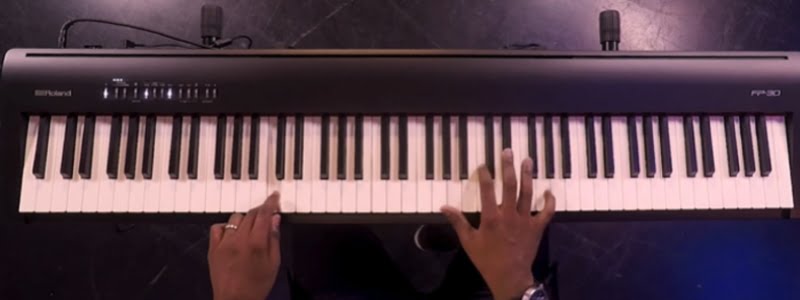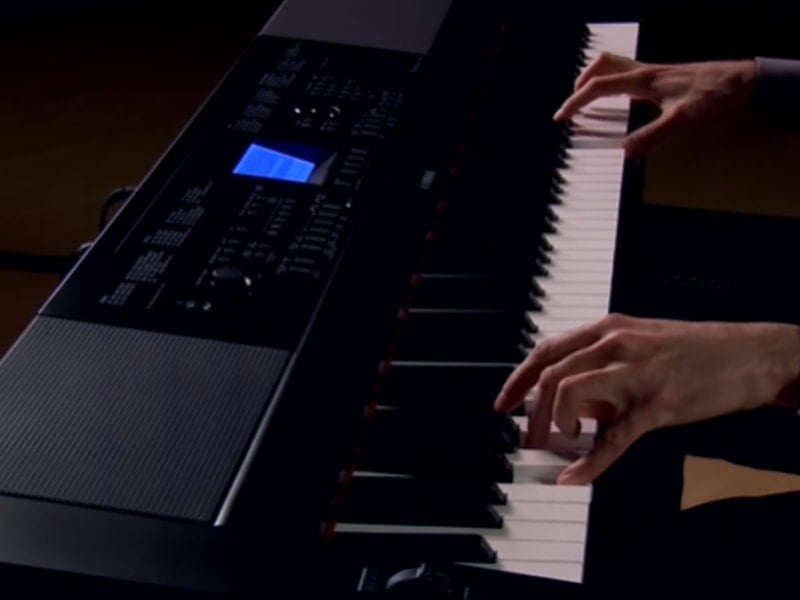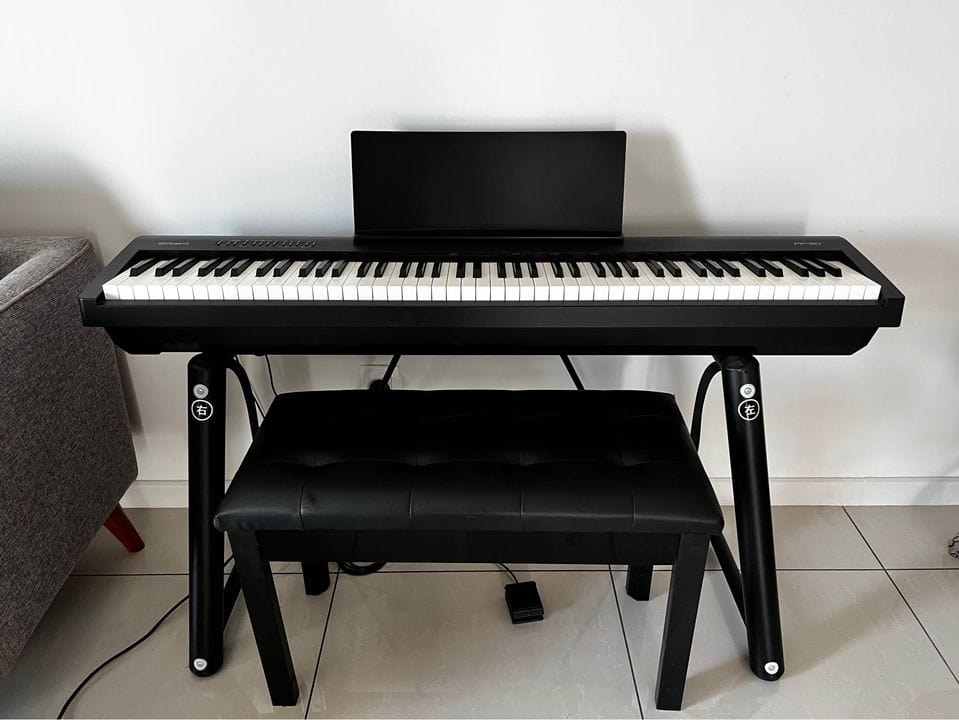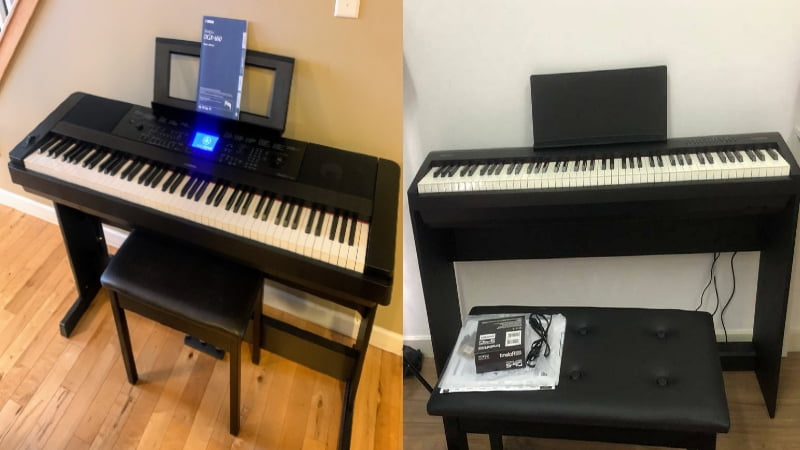Find out which digital piano is better in this Yamaha DGX 660 vs Roland FP30 comparison.
Shopping for digital pianos is a bit harder nowadays. There are endless options when it comes to digital pianos. And while having all these choices is great, it can sometimes be overwhelming.
But I’m here to make it easier for you to find the best digital piano for your needs. Two beginner-friendly models that consistently catch my eye are the Yamaha DGX-660 and the Roland FP30.
These two portable digital pianos come in at a fair price, have a cool feature set, and are made by established brands.
I found that the Roland FP-30 is the more versatile and better option overall. However, the Yamaha DGX-660 definitely comes with some features that might serve you better.
And to give you a clearer picture of both pianos, I’ve made this Yamaha DGX-660 vs Roland FP-30 comparison.
In this article, we’re diving into both of these pianos and their features. So, by the end, you’ll know exactly which digital piano is the better option for you.
Yamaha DGX 660 Vs Roland FP30: Comparison Chart




Last update on 2025-07-11 / Affiliate links / Images from Amazon Product Advertising API
Yamaha DGX 660 Vs Roland FP30: A Head to Head Comparison
It can be hard to compare two digital pianos objectively. And I figured the best way for me to do it would be by pitting certain features against each other and tallying up the total score. With this approach, the Roland FP-30 wins the comparison with a score of 3-1.
Since it has a better sound library and a more realistic feel, I found it better than the Yamaha DGX-660. However, the Yamaha still comes with some top-quality tones and a great feel that is great for beginners.
So, let’s look at the details of both pianos so you can see why I found the Roland FP-30 to be the better pick.
Tone
The winner: Roland FP-30
With digital pianos, the tone is the most important feature. You want to get a digital piano that sounds good and replicates the sound of an acoustic piano. And the thing is, both of these pianos perfectly recreate the sound of a real piano.
I’ll admit that there is a part of the tone of each piano that sounds digital, but they far exceed their price range’s expectations. However, the Roland FP-30 got the point in this specific comparison because it has a wider sound library, making it a more flexible option.
+Tone Generation
Both of these pianos use a pretty good tone engine. The Roland FP-30 uses the SuperNatural Piano Sound, while the Yamaha DGX-660 uses AWM Stereo Sampling. You can rely on either of these tone engines to produce realistic piano sounds that are much better than other pianos in the same price range.
However, keep in mind that both of these pianos use samples to generate tones. So, whenever you press a key, you trigger the piano to play a recording of the real instrument.
These pianos have a slightly more realistic tone than other pianos that use samples because of the actual recording quality. Both pianos recorded their samples with the best equipment using modern recording techniques.
When I tried out these pianos, I was pretty surprised by their tone. In fact, I would go as far as saying they can produce the most realistic tones in their price range, so when it comes to sound quality, either piano would be good.

+Sound Library
As I mentioned earlier, the Roland FP-30 is the more flexible option of the two. This is because it comes with 35 different voices. This includes 6 acoustic pianos, 7 electric pianos, and 22 other voices.
So, you won’t be limited to acoustic piano sounds with the Roland FP-30. This is great since you can use realistic piano tones for practice and when performing. But you can switch to more unique voices if you’re playing more contemporary styles.
The Yamaha DGX-660, on the other hand, only has 10 voices. Granted, this is already a lot for a digital piano, but it pales in comparison to the Roland.
That said, all of the 10 voices on the Yamaha DGX-660 are very realistic and top-quality. There are no wasted tones on the Yamaha DGX-660, which is one of the reasons it’s one of the top choices for beginners and intermediate players alike.
Feel
The winner: Roland FP-30
The next factor I had to consider was how these pianos felt. Whenever you play a digital piano, you have to sacrifice some realism when playing. However, I have to admit that for the price, both pianos do a great job of mimicking a real piano.
While both do a great job, the Roland FP-30 came out on top. This is because it comes with textured keys, which have a more realistic feel than the plastic keys on the Yamaha DGX-660.
+Hammer Action
Let’s start by looking at the hammer action. Both of these pianos have decent hammer action. In fact, I could barely tell the difference between the two when testing out the weight. And I have to say, they both did a fair job at replicating the weight I’m used to with an acoustic piano.
The Roland FP-30 uses PHA-4, which stands for progressive hammer action. This means that the keys get progressively lighter as you go up the piano. So, the lower keys will be significantly heavier than the higher keys, which is how an acoustic piano feels.
The Yamaha DGX-660 uses a similar hammer action system. It uses the Yamaha GHS or Graded Hammer Standard. It aims to accomplish the same goal as Roland’s PHA-4, which is why you can expect a very realistic weight from both of these pianos.

+Key Texture
The main reason the Roland FP-30 came out on top in this comparison was its key texture. The Roland FP-30 has textured plastic keys. So, while the keys still feel like plastic, they have a bit more texture to them, which experienced pianists will instantly notice.
On the flip side, the Yamaha DGX-660 only uses glossy plastic keys. These don’t feel bad, but they are fairly slippery and don’t feel like wooden keys at all. This won’t be a big deal for beginners, but if you’re used to the feel of a real acoustic piano, it could be a significant problem.
Piano Features
The winner: Tie
This is the one area where I think these pianos are tied. Both pianos come with a cool set of piano features that are worth considering before buying. Since these aren’t exactly premium pianos, you can’t expect them to come with the most sophisticated features, but there are definitely some worth noting.
+Polyphony
Polyphony is a piano’s ability to play multiple notes at a time. In the past, this was a huge deal as there wasn’t enough computing power to make affordable pianos with high polyphony. This isn’t the case nowadays as you can find budget pianos with more polyphony than you’ll ever need.
A great example of this is the Roland FP-30.
This piano comes with 128-note polyphony. This is more than the keys on the piano, so you won’t have to worry about playing dense chords with many notes. Even if you use dual modes that combine two different voices, the piano will be able to handle many notes at a time.
The Yamaha DGX-660, on the other hand, only comes with 64-note polyphony. However, this is more than enough for most pieces, especially if you’re only using the piano voices.
+Effects
This is one area where I think the Yamaha DGX-660 has a slight advantage.
The Roland FP-30 comes with two effects: ambiance and brilliance. This gives you a bit more control over the tone, but you won’t be able to tell the difference as a beginner.
On the flip side, the Yamaha DGX-660 only comes with one effect: reverb. While it’s just one effect, it’s way more useful than ambiance and brilliance. Besides that, it’s also much easier for beginners to use and experiment with.

Yamaha DGX 660 Vs Roland FP30: The Similarities
These pianos come with a fair amount of similarities. Even if they are made by different brands, they aren’t too different from each other.
To start, these are both pianos that won’t bust the bank. Despite coming with great tones and cool features, neither of these pianos is ridiculously expensive. That said, they aren’t the most premium models on the market either, which is something worth considering.
Since these pianos are in the same price range and designed for a similar market, they share a lot of characteristics. For example, both of the pianos have a nearly identical hammer action system.
On top of that, they are both portable digital pianos. So, while they’re great for home use, you won’t have a hard time bringing them out to performances and jams as well!
Quick Rundown of the Yamaha DGX 660
- The Pure CF Sound Engine faithfully reproduces the tone of a meticulously sampled and highly acclaimed Yamaha concert grand piano
- GHS weighted action is heavier in the low register and lighter in the high, just like an acoustic piano
- Score display puts music notation of MIDI songs on the screen, helping you play your favorites by following the bouncing ball
- The Piano room lets you choose from a variety of pianos and acoustic settings to create your own personal piano environment
- The 6 track recorder allows you to capture your performances and song ideas, then add additional layers to spice up your pieces
Last update on 2025-07-11 / Affiliate links / Images from Amazon Product Advertising API
Quick Rundown of the Roland FP30
- Rich, responsive tone from Roland renowned supernatural piano sound engine
- 88-Note Phat-4 standard keyboard provides authentic piano touch for maximum expression
- Powerful amplifier and stereo speakers deliver impressive sound
- Headphones output and quiet keyboard action allow you to enjoy playing at any time without disturbing others
- Optional matching stand and three-pedal unit provide a classic piano look and Enhanced functionality, including hands-free page turning with some sheet music apps
Last update on 2025-07-11 / Affiliate links / Images from Amazon Product Advertising API
Products Video
Related Articles to Yamaha Dgx 660
- Yamaha YDP-164 vs DGX-660: Why You Should Go for the DGX-660
- Yamaha DGX-660 vs Roland FP-90: Why the Roland FP-90 Is the Better Pick
- Yamaha DGX-530 vs 660: Why the DGX-660 Is the Better Pick
- Yamaha DGX-505 vs 660: Why the DGX-660 Is the Better Pick
- Yamaha DGX-660 vs DGX-640: A DGX Comparison
- Yamaha DGX-660 vs DGX-630: A DGX Comparison
- Yamaha DGX-620 vs 660: Finding the Best DGX Model
- Yamaha DGX-660 vs YDP-163: Which Is the Better Piano?
- Yamaha DGX-660 vs Roland Juno DS-88: Which Is the Better Piano?
- Yamaha DGX-660 vs Casio PX-360: Which Is the Better Piano?
- Yamaha DGX-660 vs YDP-144: Which Is the Better Yamaha Piano?
- Yamaha DGX-660 vs Korg Havian 30: Which Is the Better Digital Piano?
- Yamaha DGX-660 vs Casio CGP-700: Which Is the Better Pick?
- Yamaha DGX-660 vs YPG-535: Finding the Best Yamaha Digital Piano
- Yamaha DGX-660 vs P515: Is the P515 Worth the Extra Cost?
- Yamaha DGX-660 vs P-115: Which Yamaha Model Is Better?
- Yamaha DGX-660 vs Casio PX-560: Which Piano Offers More Value For The Money
- Yamaha DGX-660 vs 650: A DGX Comparison
- Korg XE-20 vs Yamaha DGX-660: Finding the Best Digital Piano
- Yamaha P45 Vs DGX-660: A Head-to-Head Comparison
- Yamaha DGX 670 Vs 660: The Distinct Difference In Details You Need To Know About
- Yamaha YDP-103 Vs DGX-660: Which Is The Better Yamaha Piano?
- Casio PX-770 Vs Yamaha DGX-660: Should You Get A Portable Or Console Digital Piano?
- Yamaha P71 vs DGX-660: Can the Amazon Exclusive Beat Out the Premium Model?
- Yamaha P125 vs DGX 660 Comparison: Can the P125 Hold Its Own Against the DGX 660?
Related Articles to Roland Fp30
- Alesis Recital Pro vs Roland FP-30: Finding the Best Digital Piano on a Budget
- Casio PX-870 Vs Roland FP-30: Which Piano Should You Choose?
- Casio PX-770 Vs Roland FP-30: Should You Get A Portable or Console Digital Piano?
- Yamaha P125 vs Roland FP30: A Close Battle Between Two Great Digital Pianos
References:
- Yamaha DGX 660: https://www.pianodreamers.com/yamaha-dgx660-review/
- Roland FP30: https://www.pianodreamers.com/roland-fp30-review/
Lulacruza is an electronic folk duo operating at the junction of the hypermodern and the ancient. Our music weaves together hypnotic female singing, South American folk instruments and electronic processing, while channeling pulsating waves from the source of creation.
Lalucruza is also a community where you can connect with other music lovers to collaborate, exchange ideas and share knowledge. A platform for who wants to learns the basics of playing piano, guitar, drum masters’ technique, etc.. is the premise of our website.
